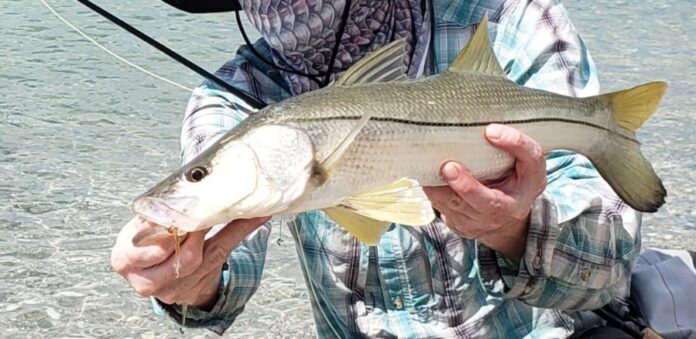Photo by Brent Wilson
Summer is the prime season for walking Florida’s beaches in pursuit of snook. Previously, I covered 5 Tactics for catching these cunning and hearty fish, so now I’d like to discuss fly selection. Generally speaking, snook flies are smaller and less flashy than you might think a predator of their size would want. And while these fish are famous for their close scrutiny of anything you throw at them, using an extremely life-like fly does not–at least in my experience–necessarily result in more success. Instead, flies that perform well in the water seem to get more strikes, so here are three of my all-time favorites:

Capt. Rick Grassett taught me the basics of beach snook fishing back when I lived in Sarasota, so of course I’m going to be partial to his fly. But this pattern’s design is ideal in several ways: minimal flash helps to avoid spooking wary fish; the sparse material doesn’t hold too much water, keeping the fly light and accurate as you pick up to re-cast; and the bead chain eyes provide just enough weight to get it down into the strike zone without making a big splash when it lands. Start your retrieve with long, slow strips until a snook starts to follow, and then switch to a more frantic pace of shorter bumps in rapid succession to convince them to eat.

As they cruise up and down Florida’s beaches, snook are looking for more than just baitfish to eat. The sands there are loaded with mole crabs, small white crustaceans about the size of the end of your thumb. They burrow into the sand near the shoreline, and frequently get caught up in the wash, where hungry snook greedily hunt them down. This particular Gotcha variant, which incorporates rubber legs to provide extra action and realism, is as good a mole-crab imitation as any. Work these very slowly and steadily across the bottom, leaving a mud trail that passing snook can follow.

If the fish are feeding aggressively near the surface, a larger baitfish pattern with a bulkier profile will often stand out from the chaos and get eaten. An unweighted Puglisi minnow is perfect for this type of scenario, not only because it pushes a lot of water, but also because it’s made from durable synthetic fibers that will stand up to the snook’s hard mouths. Try using an erratic retrieval with plenty of pauses in between to imitate a dying baitfish that sinks for a beat and then twitches back to life.
Evan Jones is the assistant editor of the Orvis Fly Fishing blog. He spent a decade living on the Florida coast and now lives in Colorado.
Credit: Source link































